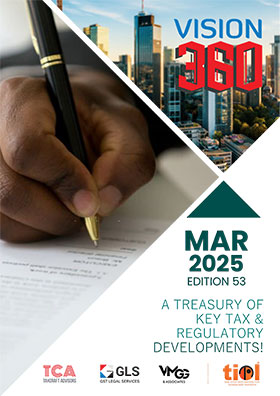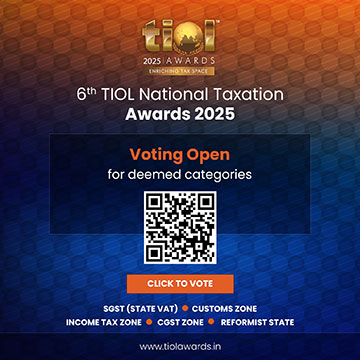The Curious Case of MRP Based Valuation
FEBRUARY 19, 2015
By Siddartha Bhatt S, Advocate
WITH exponential growth of online marketing/trading business, undoubtedly, India has emerged as the most sought after market for major foreign electronic goods manufacturers. Most of the goods manufactured by such players are sold on Maximum Retail Price (hereinafter 'MRP') basis. While importing these goods into India, additional customs duty [counter vailing duty] is calculated and paid on the basis of MRP so declared. This article analyses the new practice adopted by the Customs Department wherein these goods are attempted to be assessed on transaction value.
1. Background
Valuation of Non-MRP Goods
1.1. In terms of Section 14 of the Customs Act, 1962 read with Section 3 of the Customs Tariff Act, 1975, value of such imported goods shall be transaction value, that is the price actually paid or payable for the goods when sold for export to India for delivery at the time and place of importation, where the buyer and seller of the goods are not related and price is the sole consideration for the sale.
Valuation of MRP Goods
1.2. For the purpose of calculation of Countervailing Duty based on MRP under Section 3(1) of the Customs Tariff Act, 1975 the law provides as follows:
...in case of an article imported into India,-
(a) in relation to which it is required, under the provisions of the Legal Metrology Act, 2009 or the rules made thereunder or under any other law for the time being inforce, to declare on the package thereof the retail sale price of such article; and
(b) where the like article produced or manufactured in India, or in case where such like article is not so produced or manufactured, then, the class or description of articles to which the imported article belongs, is-
(i) the goods specified by notification in the Official Gazette under sub-section (1) of section4A of the Central Excise Act, 1944, the value of the imported article shall be deemed to be the retail sale price declared on the imported article less such amount of abatement, if any, from such retail sale price as the Central Government may, by notification in the Official Gazette, allow in respect of such like article under sub-section (2) of section 4A of that Act; or
1.3. In terms of Section 3(1) of the Customs Tariff Act, 1975, the Countervailing Duty shall be charged, in respect of an imported article, in relation to which declaration of MRP is required under the Legal Metrology Act, 2009 or Rules made thereunder and the goods are specified under Notification No. 49/2008- CE( NT) dated 24-12-2008 shall be the MRP so declared less abatement. Therefore, the value for Countervailing Duty is MRP less abatement.
2. Analysis of the Problem
2.1. Due to the prevalent high competition and price wars, the online selling companies are operating the business of electronic gadgets at wafer thin margins.
2.2. Let us take a hypothetical case of import of a Laptop. The MRP declared on the Laptop is Rs. 21,000 and transaction value [import value] of the same is Rs. 18,000. In such case, the duties would be as under:
|
Description
|
Calculation
|
Duties/Taxes
|
|
BCD [Tariff Nil]
|
18000×0%
|
0
|
|
CVD
|
21000-35%×12%
|
1638
|
|
SAD [Exempted]
|
21000×0%
|
0
|
|
Total Customs Duty
|
|
1638
|
|
VAT/CST
|
21000×5.5%
|
1155
|
|
Total Taxes/Duties
|
|
2793
|
*Calculations are illustrative and not accurate
2.3. In the above illustration, the importer incurs a cost of Rs. 18000+Rs. 2793 = Rs. 20793 towards import of goods and he effectively saves Rs. 207.
2.4. If the same transaction is assessed based on the transaction value, without providing the MRP abatement [assuming the same transaction value of Rs. 18,000 and MRP of Rs. 21,000], in such case, the duties would be as under:
|
Description
|
Calculation
|
Duties/Taxes
|
|
BCD [Tariff Nil]
|
18000×0%
|
0
|
|
CVD
|
18000×12%
|
2160
|
|
SAD [Exempted]
|
21000×0%
|
0
|
|
Total Customs Duty
|
|
2160
|
|
VAT/CST
|
21000×5.5%
|
1155
|
|
Total Taxes/Duties
|
|
3315
|
*Calculations are illustrative and not accurate
2.5. In the above illustration, the importer incurs a cost of Rs.18000+Rs.3315 = Rs. 21315 towards import of goods and he effectively incurs a loss of Rs. 315 at the point of import.
2.6. Field formations at various ports have started insisting assessment of imported goods which have marginal difference between the MRP and transaction value, to assess the CVD on transaction value instead of MRP. The reason behind this approach is that the duty payable on Transaction Value based assessment is fetching more revenue than that of MRP based valuation.
3. What is the Legal Mandate?
3.1. It is to be noted that neither Section 3 of the Customs Tariff Act, 1975 nor Section 4 and 4A of the Central Excise Act, 1944 contemplate levy of duty based on transaction value or MRP, insisting on the adoption of whichever is higher. Therefore, it is to be noted that the levy of customs duty [CVD] in all those cases where MRP based assessment is necessary, Customs Department shall not insist for assessment of the goods based on transaction value.
3.2. In addition, it is also neither the intention of Section 3 of the Customs Tariff Act, 1975 nor Section 4 /4A of the Central Excise Act, 1944 to levy duty based on MRP or transaction value after considering which yields higher duty.
3.3. There are no Circulars or instructions issued by the Central Board of Excise and Customs in this regard instructing the field formations to assess whether MRP based valuation of a product fetches less duty than transaction value based valuation and then levy duty accordingly.
4. Impact of the practice on the Trade and Consumers
4.1. It is to be noted that such a forceful assessment of MRP goods under transaction value would increase the product cost and squarely cause loss to the importer.
4.2. Assessments and clearance of goods would get delayed due to the queries raised by the formations comparing the MRP vis-à-vis the transaction value and asking the importer to assess the goods under transaction value.
4.3. Importers are likely to get discouraged from doing business in India, especially when they are dealing with goods assessable to MRP and operating at thin margins.
4.4. If the importer tries to pass the impact of duty on the consumer, the goods would be costlier to that extent.
5. Conclusion
In the light of the aforesaid discussion, I am of the view that the trading community should represent to the Board to issue a Circular clarifying that in case of MRP based assessment of imported goods for the purpose of payment of CVD, value shall be the MRP only and not "transaction value or MRP, whichever is higher".
(The author is Principal Associate, Lakshmikumaran & Sridharan, Bangalore )
|
(DISCLAIMER: The views expressed are strictly of the author and Taxindiaonline.com doesn't necessarily subscribe to the same. Taxindiaonline.com Pvt. Ltd. is not responsible or liable for any loss or damage caused to anyone due to any interpretation, error, omission in the articles being hosted on the sites)
|















